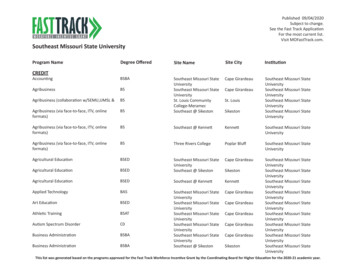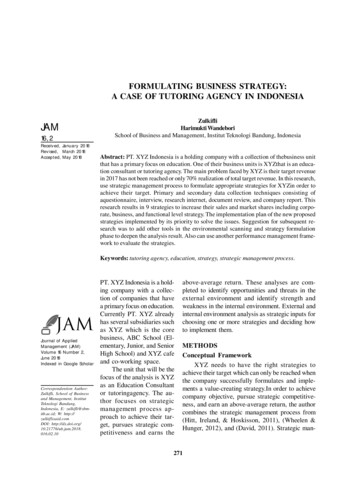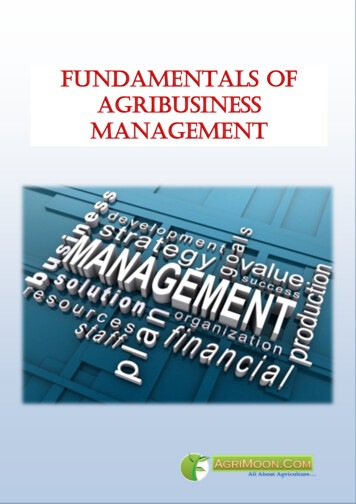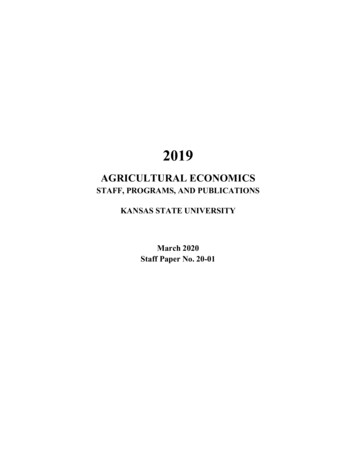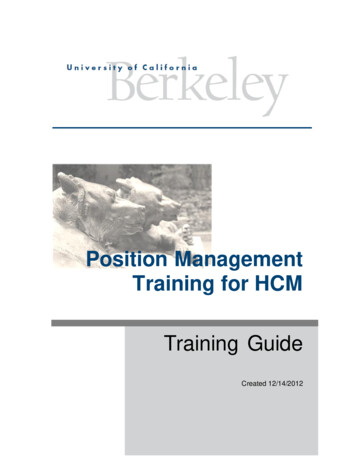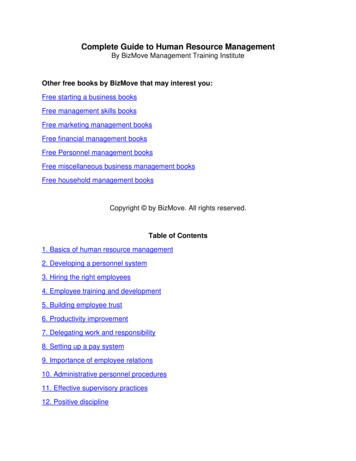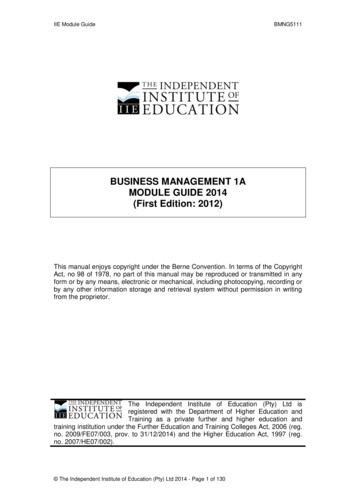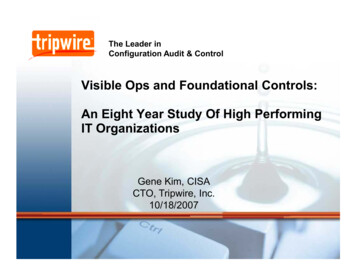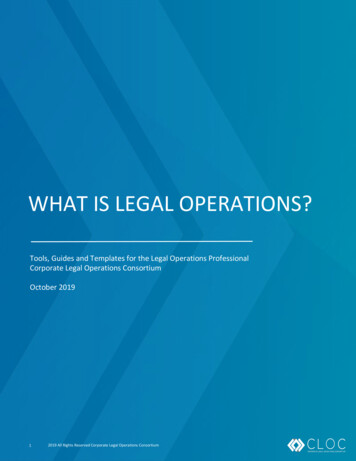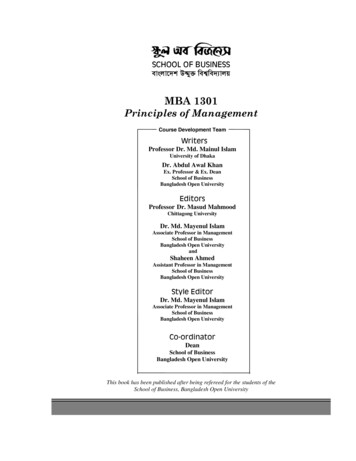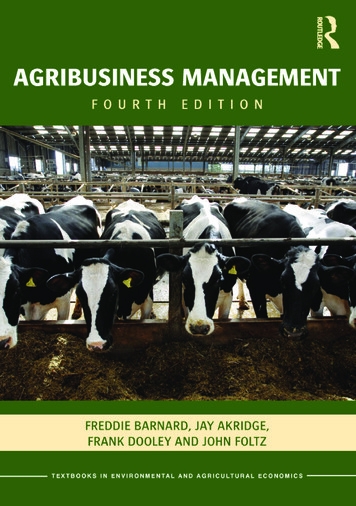
Transcription
Agribusiness ManagementToday’s food and agribusiness managers operate in a rapidly changing, highly volatile,international, high technology, consumer-focused world. This new edition of AgribusinessManagement was written to help prepare students and managers for a successful career inthis new world of food and fiber production and marketing.Agribusiness Management uses four specific approaches to help readers develop andenhance their capabilities as agribusiness managers. First, this edition of the book offers acontemporary focus that reflects the issues that agribusiness managers face both today andare likely to face tomorrow. Specifically, food sector firms and larger agribusiness firmsreceive more attention in this edition, reflecting their increasing importance as employers offood and agribusiness program graduates. Second, the book presents conceptual material ina pragmatic way with illustrations and examples that will help the reader understand howa specific concept works in practice. Third, the book has a decision-making emphasis,providing contemporary tools that readers will find useful when making decisions in thecontemporary business environment. Finally, Agribusiness Management offers a pertinentset of discussion questions and case studies that will allow the reader to apply the materialcovered in real-world situations.The bottom-line on this fourth edition of Agribusiness Management: this book is contemporary, solid on the fundamentals, practical and applicable. It provides students and adultlearners with an essential understanding of what it takes to be a successful agribusinessmanager in today’s rapidly evolving, highly unpredictable marketplace.Freddie Barnard is Professor in the Department of Agricultural Economics at PurdueUniversity, USA.Jay Akridge is Glenn W. Sample Dean of Agriculture at Purdue University, USA.Frank Dooley is Professor in the Department of Agricultural Economics at PurdueUniversity, USA.John Foltz is Associate Dean and Director of Academic Programs for the College ofAgricultural and Life Sciences at the University of Idaho, USA.
Routledge Textbooks in Environmental andAgricultural Economics1. The Economics of Agricultural DevelopmentSecond editionGeorge W. Norton, Jeffrey Alwang and William A. Masters2. Agricultural MarketingJames Vercammen3. Forestry EconomicsJohn E. Wagner4. Agribusiness ManagementFourth editionFreddie Barnard, Jay Akridge, Frank Dooley and John Foltz
Agribusiness ManagementFourth editionFreddie Barnard, Jay Akridge,Frank Dooley and John Foltz
First published 2012by Routledge2 Park Square, Milton Park, Abingdon, Oxon OX14 4RNSimultaneously published in the USA and Canadaby Routledge711 Third Avenue, New York, NY 10017Routledge is an imprint of the Taylor & Francis Group, an informa business 2012 Freddie Barnard, Jay Akridge, Frank Dooley and John FoltzThe right of Freddie Barnard, Jay Akridge, Frank Dooley and John Foltz to beidentified as authors of this work has been asserted by them in accordance withthe Copyright, Designs and Patent Act 1988.All rights reserved. No part of this book may be reprinted or reproduced or utilisedin any form or by any electronic, mechanical, or other means, now known orhereafter invented, including photocopying and recording, or in any informationstorage or retrieval system, without permission in writing from the publishers.Trademark notice: Product or corporate names may be trademarks or registeredtrademarks, and are used only for identification and explanation without intentto infringe.British Library Cataloguing in Publication DataA catalogue record for this book is available from the British LibraryLibrary of Congress Cataloging in Publication DataAgribusiness management / Freddie Barnard [et al.]. – 4th ed.p. cm.1. Agricultural industries – Management. I. Barnard, Freddie L.HD9000.5.A339 2012630.68 – dc23ISBN: 978-0-415-59695-4 (hbk)ISBN: 978-0-415-59696-1 (pbk)ISBN: 978-0-203-12418-5 (ebk)Typeset in Times New Romanby Cenveo Publisher Services2011038607
ContentsList of platesList of figuresList of tablesAbout the authorsPrefaceAcknowledgmentsviiixxixiiixvxixPART IAgribusiness management: scope, functions, and tasks11The business of agribusiness32Managing the agribusiness363Economics for agribusiness managers59PART IIAgribusiness management: organization and context754The organization of an agribusiness775International agribusiness99PART IIIMarketing management for agribusiness1216Strategic market planning1237The marketing mix1438Tools for marketing decisions in agribusiness178
viContentsPART IVFinancial management for agribusiness9 Understanding financial statements19519710 Analyzing financial statements22411 Financing the agribusiness24912 Tools for evaluating operating decisions27413 Tools for evaluating capital investment decisions298PART VOperations management for agribusiness32114 Production planning and management32315 Supply chain management for agribusiness346PART VIHuman resource management for agribusiness36716 Managing organizational structure36917 Managing human resources in agribusiness395GlossaryIndex417446
List of platesPart I Retail food shot1.1 Traditional agriculture1.2 Man shopping1.3 Input application2.1 Man and woman planning2.2 Man pouring crop protection products2.3 Cherries3.1 Landscaping3.2 SalesladyPart II Apples on display4.1 Presentation to a group4.2 Woman at computer4.3 Fragrant Floral5.1 Lettuce harvest5.2 Grain harvest equipment5.3 Woman riding planterPart III Windmills6.1 A customer interview6.2 Dairy cows7.1 Marketing mix7.2 New product development7.3 Personal selling8.1 Livestock production8.2 Focus group discussionPart IV Shot of money9.1 Recordkeeping using a computer9.2 Farm land and farmstead9.3 Grain elevator10.1 Tools10.2 Grocery inventory10.3 Nursery11.1 Dairy barn expansion11.2 Harvesting equipment12.1 Ripple rings of water12.2 Nursery12.3 Grain 85
viiiPlates13.1 Irrigation equipment13.2 Extended hands13.3 ApplicatorPart V Production process14.1 Fresh produce14.2 Strawberries15.1 Two men inspecting a watermelon15.2 Grain loaded onto a shipPart VI Man working in a lab16.1 Hands16.2 Producer and consultant17.1 Man training employees17.2 Man and son in a hog barn17.3 Man and young man using 2
List of figures1.1Farm value and the marketing bill for consumer food expenditures,1993–20091.2 2008 farm-food marketing bill1.3 Industry sector value-added for the 2008 food marketing bill1.4 Factor payments for the 2008 food marketing bill1.5 The food production and marketing system1.6 Food sales by retail sector, 1986–20091.7 Number of food stores, by category, 1997–20081.8 Sales of food at home and away from home, 1990–20091.9 Percentage of sales of food-at-home and away-from-home, 1960–20201.10 Composition of total value-added by food processors, 20071.11 Distribution of farms by sales class, 20072.1 The wheel of management2.2 Levels of planning and goals for seed company2.3 Organizational chart for Carlson seed company2.4 Management by exception graph for Phoenix fertilizer3.1 Supply and demand of cereal3.2 Shortages and surpluses with supply and demand3.3 Shifts in supply curves3.4 Shifts in demand curves3.5 Demand for bluegrass seed5.1 World population distribution by region, 1800–20505.2 World population growth5.3 Countries of the world by Gini coefficient6.1 The market planning process6.2 SWOT analysis6.3 Mass market strategy6.4 Market segmentation strategy7.1 The marketing mix7.2 The value equation7.3 The total product concept7.4 Categories of new technology adopters7.5 The product life cycle7.6 Upper and lower limits on pricing decisions7.7 The promotion strategy process7.8 Major agribusiness distribution 4105105127128132133144146147149151153159171
16.216.316.416.516.616.7Marketing audit proceduresGap analysisSales forecasting modelMarket mapProfitability analysis model for Brookstone Feed and Grain companyGraph of key ratios for Brookstone Feed and Grain companyTotal fixed costs, LCM Nursery, Inc.Average fixed costs, LCM Nursery, Inc.Total variable costs, LCM Nursery, Inc.Average variable costs, LCM Nursery, Inc.Total variable costs with supplier discounts, LCM Nursery, Inc.Changes in total fixed cost, LCM Nursery, Inc.Volume–cost relationships for Brookstone Feed and Grain companyOperations management systemProcess layout—farm implement manufacturing facilityProduct layout—fluid milk facilityHybrid layout—supermarketFixed position layout—farm buildingSupply chain management processSimplified master production schedule processPeriodic review inventory systemContinuous review inventory systemChanges in procurement with shift to supply chain managementLine organizationLine and staff organizationFunctional organizationThe leadership continuumMaslow’s needs hierarchyHerzberg’s two-factor theoryExample of Vroom’s expectancy 8338339340349351358358364374375376380385388389
List of 36.16.27.18.19.19.29.39.49.59.69.7Contribution of the food and agricultural industries to the U.S.economy, 2009Indicators of U.S. agriculture sector efficiencySales of the ten largest U.S. food retailers in 2009Concentration ratios for top four, eight, and twenty firms’ share ofU.S. grocery store sales, 1992–2009Farm characteristics, by type of farm, 2007Number of farms, land in farms, average size of farm, 1970–2009Net income from farming, 1970–2009Farm production expensesLevels and nature of planning in the agribusinessSusan Lambert’s accounting and economic profitDemand and supply schedules for cerealInterpretation of price elasticity of demandCharacteristics of developed and developing markets for foodUSDA agricultural trade valuesComparing exporting and investing in international marketsCharacteristics of product-driven, sales-driven, and market-drivenorganizationsAssessing internal strengths and weaknessesJob description for feed salespersonCompetitor strength and weakness analysisBalance sheet for Brookstone Feed and Grain company, December 31, 2009Income statement for Brookstone Feed and Grain company, year endingDecember 31, 2009Statement of owner’s equity for Brookstone Feed and Grain, year endingDecember 31, 2009Statement of cash flows for Brookstone Feed and Grain company, year endingDecember 31, 2009Balance sheet for Aggieland Landscaping company, year endingDecember 31, 2011Pro forma statement of cash flows for Aggieland Landscaping company,year ending December 31, 2012Pro forma balance sheet for Aggieland Landscaping company, year endingDecember 31, 03204216218218219219
lesDixie manufacturing company comparative balance sheetsPacey farm store expense budget and control reportAccount aging scheduleSales increases required to offset bad debt lossesABC farm supply store condensed balance sheetABC farm supply store condensed income statementExample of the repayment schedule for a 5000 loanCash flow statement for three months ending March 2012Pro forma monthly income statementPro forma balance sheetIncome statement for Brookstone Feed and Grain, year endingDecember 31, 200912.2 Classification of fixed and variable costs for Brookstone Feed and Graincompany13.1 Future value of 1 (compounded annually)13.2 Present value of 1 (compounded annually)13.3 Future value of 1 at compounded interest for an equal series of payments13.4 Present value of 1 at compounded interest for an equal series of payments13.5 Self-propelled fertilizer applicator simple rate of return calculations13.6 Expansion of the grain storage simple rate of return calculations13.7 Net cash inflows for the self-propelled applicator investment13.8 Net present value for applicator investment with 14 percent discount factor13.9 Net present value for applicator investment with 15 percent discount factor13.10 Estimated net profit and depreciation expense for new sizing equipment14.1 Examples of production systems and components14.2 Characteristics of goods producers and service providers14.3 Sales and marketing statistics for BioAg15.1 Reasons for different inventory levels17.1 Example of job specifications17.2 Example of a job description17.3 Example of a job application17.4 Culpen County Farmers’ Co-op: employee 04305307311312315315317319325326344355399400402409
About the authorsDr. Freddie Barnard is Professor in the Department of Agricultural Economics at PurdueUniversity. He works in the area of agricultural finance and focuses on two major groups:agricultural lenders and producers. In addition, he teaches the undergraduate course in agribusiness management. He is involved in educational projects across the country that educatelenders on how to improve the quality of decision-making. Examples include his work withthe industry-wide Farm Financial Standards Council that provides uniformity in financialreporting and analysis for the agriculture industry. He also prepares instructional materialsfor agricultural lenders and producers, and teaches at several agricultural credit schoolsacross the country.Dr. Jay Akridge is the Glenn W. Sample Dean of Agriculture at Purdue University. He isresponsible for administering the academic programs in the College of Agriculture, theIndiana Agricultural Experiment Station, and the Purdue Cooperative Extension Service.Before being named Dean he was the James and Lois Ackerman Professor of AgriculturalEconomics and served as director of the Purdue Center for Food and Agricultural Businessand the MS-MBA in food and agribusiness management. He has received several awardsfor teaching, including the Charles Murphy Award for Distinguished UndergraduateTeaching—Purdue’s highest teaching award—and the USDA Food and AgriculturalSciences Excellence in Teaching Award. He was added to the Purdue University Book ofGreat Teachers in 2003. His research has examined the buying behavior of commercialagricultural producers, innovations in marketing strategies by agribusiness firms, and adoption of new technology by agribusiness. He has worked with agribusiness managers in theareas of strategy and marketing in many countries including Lithuania, Australia, Argentina,Cameroon, and China. A native Kentuckian, his family owns and operates a fourth-generation farm supply business in Fredonia, KY.Dr. Frank Dooley is a Professor at Purdue University in the Department of AgriculturalEconomics. He has won many awards for outstanding teaching and advising, including theAgricultural and Applied Economics Association Outstanding Undergraduate Teacher andthe Charles B. Murphy Outstanding Undergraduate Teaching Award from PurdueUniversity. He is also an active presenter in programs at the Center for Food and AgriculturalBusiness. His research program in agribusiness focuses upon transportation and supplychain management. His work has studied issues in the food manufacturing and retailing,ethanol, transportation, and country grain elevator industries.Dr. John Foltz is Associate Dean and Director of Academic Programs for the College ofAgricultural and Life Sciences at the University of Idaho. He works with student academic
xivAbout the authorsissues and student organizations as well as student recruitment and retention efforts for theCollege. Previously, he served as a Professor in the Department of Agricultural Economicsand Rural Sociology. He is an award-winning teacher and advisor, having received hisCollege’s Outstanding Advising award, and the University of Idaho award for teachingexcellence. He is a seven-time recipient of the University of Idaho’s Faculty ExcellenceAward, chosen by students as their most influential faculty member. His research has lookedat country-of-origin labeling (COOL) in the beef industry; exploring the feasibility ofcarbon credit marketing by Idaho dairies; investigating the demand for consultants by Idahodairy and potato farmers; researching consumer perceptions of trout as a food item; andteaching research involving class attendance and student performance, building the industry–institution interface and the use of case studies in the classroom. He co-writes abi-monthly management column for Feed and Grain magazine. He received his Bachelor’sand Master’s degrees from Ohio State University. Upon graduation, he worked as a districtmanager for Ralston Purina in Ohio and Pennsylvania marketing livestock feed and animalhealth products. Subsequently, he received his Ph.D. in agricultural economics fromPurdue.
PrefaceThis is an exciting time to be involved in the food and agribusiness industries. Internationalmarkets are an inseparable reality for agribusiness managers. Information technology andthe Internet make entirely new models for conducting business both possible and practical.Biotechnological developments raise exciting and challenging business and policy issues.Relationships among players in this system have continued to evolve and, as a result, thefood production and marketing system is far more complex and interrelated today than itwas a mere decade ago. Add to this the challenge of feeding an estimated nine billionpeople on earth by 2050—and agriculture and agribusiness will continue to be the nexus ofattention!This rapidly changing, highly volatile, international, high-technology, consumer-focusedworld is the one in which today’s food and agribusiness managers operate. This fourthedition of Agribusiness Management was written to help prepare students and managers fora successful career in this new world of food and fiber production and marketing.What’s newThe basic objective of this text has not changed through four editions: to give students andmanagers a fundamental understanding of the key concepts needed to successfully managebusinesses, adding value to farm products and/or providing inputs to production agriculture.While there are many concepts in this book that will apply to the farm or productionagriculture business, the text is focused on the food and input supply sectors of the foodproduction and marketing system.This new edition of Agribusiness Management uses four specific approaches to help readers develop and enhance their capabilities as agribusiness managers. First, it offers acontemporary focus that reflects the issues that food and agribusiness managers face bothtoday and likely will face tomorrow. Specifically, food sector firms and larger agribusinessfirms receive more attention in this edition, reflecting their increasing importance asemployers of food and agribusiness program graduates. Second, the book presents conceptual material in a pragmatic way with illustrations and examples that will help the readerunderstand how a specific concept works in practice. Third, it has a decision-making emphasis, providing managerial tools that readers will find useful when making decisions in thecontemporary business environment. Finally, it offers a pertinent set of discussion questionsand case studies that will allow the reader to apply the material covered in real-worldsituations.More specifically, the opening section of the text has been completely re-organized tohelp students better understand the food and agribusiness marketplace, as well as management
xviPrefaceand basic economic principles. The second section includes chapters on forms of businessorganization and international agribusiness management, which is an area no contemporarybook on agribusiness can ignore. In the third section, we start our discussion on the fourfunctional areas of management—marketing, finance, supply chain, and human resources.Ultimately, all business activity revolves around the customer, and the text reflects thiscustomer-oriented philosophy. The marketing management section has been substantiallyrevised to reflect the current thinking in this area. The finance section also received acomplete overhaul, and includes chapters on financial reporting and analysis, with increasedemphasis on credit analysis and management. The fifth section, supply chain management,was completely rewritten to reflect the current thinking in this area. Finally, the humanresource section was re-written, again to reflect what we now know about managingpeople.Preparing for a new food and agribusiness market requires the application of concepts andtools to current situations. This edition of Agribusiness Management ends every chapterwith discussion questions that are either new or have been revised for this text. Alsoincluded are cases that cover a variety of situations and types of firm. We feel you will findthis mix of cases to be a distinguishing feature of the book.The bottom-line on this fourth edition of Agribusiness Management: this book is contemporary, solid on the fundamentals, practical and applicable. It provides students and adultlearners with an essential understanding of what it takes to be a successful agribusinessmanager in today’s rapidly evolving, highly unpredictable marketplace.The readershipAgribusiness Management was written for students. There are tremendous career opportunities in the food and agribusiness industries. In this book, you will be exposed first to thebreadth of these opportunities, from research and development manager for a biotechcompany, to a logistics manager for a major food retail organization. You need to understand the marketplace and some of the unique institutional features of the food productionand marketing system before embarking on a career as an agribusiness manager. Preparingfor a career in agribusiness management also requires that you understand the fundamentalsof management—the basic tasks of planning, organizing, directing, and controlling and thebasic functions of marketing, finance, operations and logistics, and human resource management. In this book you will find all of these topics covered in a straightforward way. And,we hope the many food and agribusiness examples and case studies bring these concepts tolife for you. This is a book you will continue to use as a reference as your managerial careerunfolds.Agribusiness Management was written for managers and soon to be managers who arealready in the workforce. We have had the opportunity over the past 25 years to work withliterally thousands of managers through the activities of the Center for Food and AgriculturalBusiness at Purdue University. Most of the case studies and examples in this book comefrom these industry relationships and interactions. As the business environment changes,and as people assume new responsibilities, we see a need to retool in areas that an individualhas not recently been applying in his/her job. For example, the production manager in a foodprocessing firm who has been asked to serve on a task force focused on helping the firmbecome more customer oriented may need a “refresher” in marketing management. Theseindividuals (and corporate learning and development directors and training managers) willfind this book useful in sharpening their skill set.
PrefacexviiAgribusiness Management was written for instructors. Over time, we have found thatevery instructor has his or her own take on what an agribusiness management course shouldlook like. Some are introductory courses, other have more of a capstone orientation. Someof these courses are part of an entire curriculum in agribusiness management. In other cases,a program may offer only a course or two in the agribusiness area. The organization of thisbook is structured in a way that instructors will find convenient when developing theircourse, wherever that course fits in the program’s overall curriculum.An instructor could easily use the material in this edition over a single semester, or overa two semester or three-quarter course, covering each topic in more detail. Some instructorswill find that moving through the book from start to finish sequentially as part of a onesemester course makes the most sense. Others may drop chapters on specialized topics likeinternational business or human resource management, because these topics are covered inother courses. For an advanced course, the book has plenty of rigor. Supplemented withoutside case studies, this is an excellent text for a capstone-type course where the materialhere would be covered more quickly, and more time spent on some of the more advancedideas. The new and updated cases and the discussion questions will be of value to all instructors as they serve the needs of students hungry for applications and illustrations of theconcepts and tools covered in the book.Outline of bookIn Part I, “Agribusiness Management: Scope, Functions, and Tasks,” we focus on the foodand agribusiness industries and the role of the agribusiness manager. In addition, a set ofeconomic concepts of fundamental importance to agribusiness managers is covered. Part Iexposes readers to the tremendous variety of firms that comprise the food production andmarketing system. The core focus of this book is the four functional areas of management—marketing, finance, supply chain, and human resources. Readers will better understand therole that managers of food and agribusiness firms play as they execute the four tasks ofmanagement—planning, organizing, directing, and controlling.Part II, “Agribusiness Management: Organization and Context,” leads readers towardbetter understanding the context or environment in which agribusiness managers operate bytaking them inside the different forms of business organization, including cooperativesgiven their prominence in the food and agribusiness markets. This section also provides aglimpse into the issues an agribusiness manager must face when doing business outside ofthe United States. The challenges of serving international markets, of sourcing raw materialsfrom international locations, and from competing with international firms have all emergedas key issues in the past decade. Looking to the future, this area promises to be even moreimportant.We begin our look at the four functional areas of management in Part III with “MarketingManagement for Agribusiness.” This section covers the fundamental concepts and tools anagribusiness manager uses in identifying its target market, and taking its product-serviceinformation offering to the market. The marketing mix—product, price, promotion, andplace—is covered in some detail. In addition, important tools for making marketing decisions are discussed. All of this material is presented in the context of the strategic marketingplanning framework.Part IV, “Financial Management for Agribusiness,” starts with basic financial statements,and moves through financial ratios and financing the agribusiness on to tools for makingoperating and capital investment decisions. This section addresses the fundamental elements
xviiiPrefaceof finance that any agribusiness manager should understand. A series of integrated examples, and clear explanations of key terms, will help you better understand the language andconcepts of finance. More importantly, you will better understand how to use financialinformation when making managerial decisions.Part V, “Operations Management for Agribusiness,” looks at supply chain management.This section takes you into areas such as production planning, total quality management, andlogistics management. Production/operations and supply chain management in agribusinessfirms have undergone a profound change over the past two decades. And, these two chapterswill provide a fundamental understanding of the key elements in this important area.Finally, in Part VI, “Human Resource Management for Agribusiness,” we look at keyissues involved in managing a firm’s people resources. First, we explore issues aroundorganizational structure and leadership. Then, we turn our attention to the personnel functions of hiring, training, evaluation, and compensation of employees. The final section—the issues surrounding the human resource area—are likely the most pressing of all to anagribusiness firm facing a rapidly changing operating environment.This is an exciting time to be preparing for or retooling for a career in the food and agribusiness industries. We have tried to capture some of that excitement in AgribusinessManagement. We hope that you find this book readable and interesting, challenging, andpragmatic, and most of all helpful as you better prepare yourself or your students forsuccessful careers in the food production and marketing system.Web-based supplementsAgribusiness Management is supported by a set of supplementary materials, which areavailable at the text’s support Web site: 61/
AcknowledgmentsAny large project involves an equally large number of individuals, and this book is noexception. Our most important acknowledgment is to Research Development EditorKathleen Erickson, who served a variety of roles while working on both the third and fourtheditions, ranging from conducting background research to discussing content and focus asboth editions of this manuscript moved from idea to reality.Also, we want to acknowledge the work done on previous editions of this textbook byDrs. Steven P. Erickson and W. David Downey. Their work provided the foundation for thefourth edition. Dr. Erickson passed away before the third edition of this book was published.He was a brilliant, award-winning educator, who received numerous teaching awards,including the American Agricultural Economics Association’s Distinguished UndergraduateTeaching Award and the Charles B. Murphy Award for Outstanding UndergraduateTeaching (Purdue’s highest teaching awar
Feb 06, 2018 · contemporary business environment. Finally, Agribusiness Management offers a pertinent set of discussion questions and case studies that will allow the reader to apply the material covered in real-world situations. The bottom-line on this fourth edition of
